-

人教版高中英语必修1English around the world说课稿
(3)v. 给:提出;展现,显现present sb. with sth. ; present sth. to sb. 把. . 交给;颁发;授予present sth. (for sth. )/present sth. to sb. e. g. Om his birthday, his friends presented him a collection of stamps. 在他生日时,他的朋友们送给他一套邮票作为礼物。The sword was presented by the family to the museum. 这家人把宝剑捐赠给了博物馆。The committee will present the final report to Parliament in June. 委员会将在六月向议会提交最后的报告。You need to present yourself better. 你需要更善于展现自己。It is essential that we present a united front. 至关重要的是我们要表现得更加团结。Step 4 ConsolidationT:Now that we have got a general idea of these words and phrases. Lets make up some sentences using them to master them. Suggested sentences:1. Your duties include typing letters and answering the telephone. 2. It is one of the greatest roles that she has played. 3. A large number of people have applied for the job. 4. The number of the panda is declining. 5. I'11 go there, even if I have to walk. 6. He came up to me to ask for a light. 7. The novel is about a family who can't communicate with each other. 8. He based his plan on interests of most people. 9. Why doesn't he make use of his singing talent?Step 5 Summary and homeworkT:Today we dealt with several new words and phrases. After class I hope that youcan read them again and again to keep them in mind. That's all for today. You aredismissed.

人教版高中英语必修1Nelson Mandela--A Modern Hero说课稿
In this step, give students a few minutes to read the passage . While they are reading, I will write some key words of the text on the blackboard. Then ask students to retell the passage according to the key words.By retelling, students can improve their ability of language organization and have an overall understanding of the article.Step 4 Group discussionIn this step, students will be divided into groups of 4 to discussion the following question: What qualities make a great person?After their discussion, invite a few groups to make a report to the class.This group discussion can practice students’ oral English and cultivate their abilities of cooperation and communication.Step 5. HomeworkLet students write a short passage to introduce a great person he or she admires.The homework can consolidate the knowledge the students have learned and cultivate their writing ability. Part 6 Blackboard Design(板书设计)That’s all my teaching procedures. Finally, I’d like to say sth about part 6 blackboard design. On the top is the title. On the left, there will be some new words and expressions. In the middle of the blackboard, I will write some useful sentence structures so that the students can know clearly what they’ve learned and then try to master the knowledge.OK. That’s all for my presentation. Thank you for your attention.

人教版高中英语必修2Cultural Relics说课稿2篇
Ⅲ. Analysis of the teaching material:The topic of this unit is cultural relics. Students are quite interested in topics about different cultures around the world. This is the second period of the whole unit. As a reading class, the passage mainly talks about the history of the amber room (how it was made, sent as a gift, lost and rebuilt).According to the new national curriculum, when teaching reading, much emphasis should be put on training the students’ reading skills.Ⅳ. Teaching objectives1. Language objectives:1) Students are required to master the key words and phrases occurred in the passage (e.g. amazing, decorate, belong, in return, less than etc.)2) Students are required to learn the attributive clause and acquire the sentence pattern.2. 1) Students are required to describe a certain thing by using the new sentence patterns.2) Students are required to master two kinds of reading skills—skimming and scanning, and learn to use them in their daily reading.3. 1) Students are required to know the history of the amber room.2) Students are required to appreciate cultural relics and understand the importance of protecting them.Ⅴ. Teaching important and difficult points1) the new words, phrases, and sentence pattern in the course of reading.2) Teaching difficult point: Help the students master two kinds of reading skills—skimmingand scanning and learn to apply them in daily use.Ⅵ. Teaching methods:Task-based method & Top-down model Ⅶ. Teaching aids: PPT, pictures, blackboard Ⅷ. Teaching procedure:

人教版高中英语必修2The Olympic Games说课稿2篇
Purpose of my design:To ask the students to do these two tasks will make the Ss predict the story of this passage. As a result, it will deepen Ss’ memory of this story because they will have their own understanding of this story.Step 3. While-readingTask 1. (Individual work _____min)Skimming: ask students to skim the text and the main ideas of each paragraph in this passage. Please read it quickly and then match the sentences with the letters.Task 2. (Individual work _____min)Scanning: read the text quickly and decide the whether the following statements are true or false and give reasons.Task 3. (Pair work _____min)Listen to the tape and fill in the banks. Then read the paragraph with expression to your partner.Task4 (individual work min)Listen to the tape again and write down the main idea in one sentence.Purpose of my design: Enable students to understand the given material better by using different reading skills. And proper competition can arouse the Ss’ interest in English learning. “Task-based” teaching method is used here todevelop the Ss’ ability of communication and also their ability of co-operation will be well trainedStep 4. Post-readingTask 1. (Individual work, pair work, group work, class work; _____min)Discussion (group of 4):1. If you were Hippomenes, would you run against Atlanta?2. Do you think Hippomenes deserved to win the race? Why or why not?Step 5. HomeworkPlease read the story again carefully after class and imagine: What will happen during the race between Hippomenes and Atlanta? Who do you think will win the race? Do you think Atlanta would marry Hippomenes? Write an end for the story with thses questions.Purpose of my design: Homework is so important and necessary for to master the knowledge they learned after class. It will check whether the Ss achieve the teaching aims.Part 5 Blackboard design

人教版高中英语必修4Women of achievement说课稿4篇
Good morning, distinguished judges:It’s my honor to talk about my teaching ideas with you. Today my topic is Women of Achievement. My presentation consists of six parts: the analysis of teaching material and student, teaching aims, key and difficult points, teaching and studying method, teaching procedures and blackboard design.First, let’s focus on the analysis of teaching material. This lesson is from New Senior English for China Student’s Book 4 Unit 1, the reading part. The main topic of the passage is the introduction of a student of Africanwildlife. After this lesson, the students will learn more information about her studying chimps in Africa, and their reading and speaking abilities can be developed as well.The next part is the analysis of students. My students are in senior high students. They have learnt English for many years, they’ve known many words and sentences, but their speaking and reading abilities are still not very good. So I will practice their speaking and reading abilities through different exercises.According to the New Standard Curriculum and the present situation, I set the teaching aims as follows: firstly, knowledge aims. Students can grasp some new words, such as worthwhile, move off. Moreover, students can understand the content of the passage and get familiar with the topic of studying chimps in wildlife. Secondly, ability aims. Students can use reading strategies such as skimming and scanning in reading process. Thirdly, emotional aims. Students can have the awareness of protecting animals and care about animals.Based on the above analysis, the key point of this lesson is to get the main idea and the detailed information from the passage; the difficult point is to talk about the wildlife protection and use reading strategies.

人教版高中英语必修5Great scientists说课稿4篇
通过写文章梗概,培养学生综合运用语言的能力,学习用恰当的英语描述科学家的故事。这是本课的教学难点。教师可以使用完形填空的方式来帮助学生整理语篇,从而来降低难度。本课的教学重点的突破方法是:在阅读前,让学生初步了解得出科学观点所需要的基本程序,从而轻松而自然地导入文章的阅读;在阅读过程中,由易到难设计快速阅读和精读的问题,层层推进各种阅读活动,让学生对阅读内容从整体感知到细节理解,最后深层读懂整篇文章,同时加强阅读策略的指导,让每个学生都主动参与课堂教学活动,最终达到提高阅读能力的目的。Step 4 Post-readingGroup Activities四人小组共同合作,在老师的适当指导下,就以下2个问题展开讨论,让学生就所知、所学、所感和所想融入话题,然后抽若干同学代表作小组发言。1. What do you think about John Snow, and what should we learn from him?2. Cholera was 19th century disease, which two diseases are similar to cholera today? Why?

人教版高中英语必修5Life in the Future说课稿5篇
Good afternoon, everyone. It’s my great pleasure to be here sharing my lesson with you. The content of my lesson is Senior English for China Book5 Unit 3 Life in the Future. I’ll be ready to begin this lesson from six parts: Analysis of the teaching material, Analysis of the students, Teaching aims and important and difficult points, Teaching methods and aids, Teaching procedures, and Blackboard design. First, let me talk about the teaching material.Part 1 Analysis of the Teaching Material:This unit is about what human beings’ life will be like in about one thousand years. By studying of this unit, we’ll Enable the students to know the changes in humans’ life and some new inventions bringing about the change and develop the interest in science. This lesson plays an important part in the English teaching in this unit. This is an important lesson in Book Five. From this lesson, it starts asking the Ss to grasp contents of each passage. Therefore, this lesson is in the important position of the teaching material. If the Ss can learn it well, it will be helpful to make the Ss learn the rest of this unit.Part 2 Analysis of the SsAs Senior2 Ss, they are at different levels of English fluency, some of them have lost interest in English. So during the lesson, I arrange a variety of activities to let all of them join in to attract their interest and let them be confident and taste the joy of success.

人教版高中英语必修5Making the news说课稿4篇
今天我们来介绍一下必修五第四单元的授课方式。这个单元的题目是Making the news。应该是学生比较感兴趣的话题,学生往往对新闻工作充满好奇,所以我们可以利用这个机会多设计一些师生互动和学生互动,来激发起学习的积极性,提高学习效率。同时我们可以利用这个单元不仅帮助学生掌握语言知识,培养语言能力,同时让其了解新闻工作的重要性,培养起社会智能感。这个单元分为六个课时,它的教学目标是这样的:语言目标是掌握词汇表中的常用单词和短语,掌握倒装句的一些基本用法。 技能目标是能初步掌握约会的基本句型并在真实的场景下正确运用。新闻报道类文章的写作技能。采访的基本规范和沟通技能。情感目标是对新闻报道的客观性和真实性有更好的理解。对新闻记者的职业有更深入的了解,并能体会其工作的重要性。下面我们来介绍一下第一课时的授课方式,第一课的教学目标是这样的第一课时的教学目标语言目标:单词:Occupation, journalist, editor, photographer, curious, personality, enthusiasm

人教版高中英语必修5The United Kingdom说课稿4篇
Teaching Aims:Knowledge 1. Get the students to learn the useful new words and expressions in this section. Aims:2. Let the students learn about how the UK was formed and the four groups of invaders.1. Develop students’ reading ability and let them learn different Ability reading skills. Aims:2. Enable students to learn to talk about the United Kingdom and the Union Jack Emotional 1. Let students know more about the UK2. Develop students’ sense of cooperative learning Aims:Teaching Important Points:1. Let the students learn about the countries of the United Kingdom and the Union Jack2. Get the students to read the passage and know about how the UK was formed and the four groups of invaders.3. Have the students learn different reading skills.Teaching Difficult Ponts:1. Develop students’ reading ability.2. Enable students to talk about the United Kingdom and the Union Jack.3. Let students learn how the UK was formed geographically and historically.Teaching Methods:Showing pictures, asking, exercising, listening, reading etc.Teaching Aids:A computer,a projector and a blackboard.Teaching Procedures: 1) Show a map of the world, ask students the following questions:Where is the UK?What’s the full name of the UK?2) Ask the students work in pairs to do the quiz on Page 9.Do you want to test how many things you know about the United Kingdom? Let’s have a small test.Using the map on P9, students answer the following questions:?How many countries does the UK consist of? What are they??England is divided into three main areas. Do you know what they are? 1) Scanning (10Minutes )Let the students hold the questions asked in pre-reading and read the passagequickly and then let them do the following exercise.Join lines to the right answer.
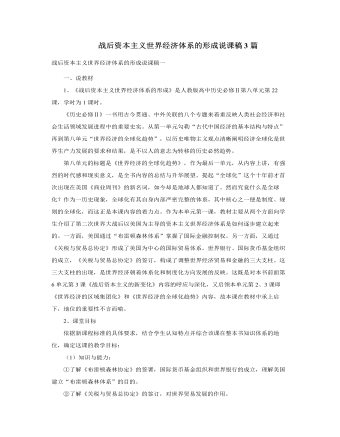
人教版高中历史必修2战后资本主义世界经济体系的形成说课稿3篇
1、《战后资本主义世界经济体系的形成》是人教版高中历史必修Ⅱ第八单元第22课,学时为1课时。《历史必修Ⅱ》一书用古今贯通、中外关联的八个专题来着重反映人类社会经济和社会生活领域发展进程中的重要史实。从第一单元勾勒“古代中国经济的基本结构与特点”再到第八单元“世界经济的全球化趋势”,以历史唯物主义观点清晰阐明经济全球化是世界生产力发展的要求和结果,是不以人的意志为转移的历史必然趋势。第八单元的标题是《世界经济的全球化趋势》,作为最后一单元,从内容上讲,有强烈的时代感和现实意义,是全书内容的总结与升华展望。提起“全球化”这个十年前才首次出现在美国《商业周刊》的新名词,如今却是地球人都知道了。然而究竟什么是全球化?作为一历史现象,全球化有其自身内部严密完整的体系,其中核心之一便是制度、规则的全球化,而这正是本课内容的着力点。
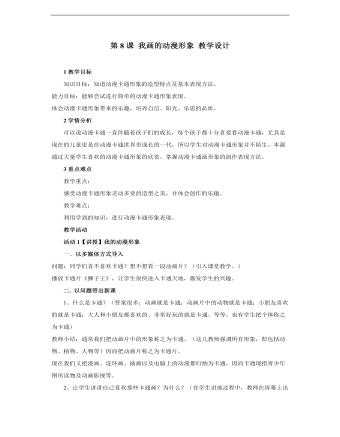
小学美术人教版四年级下册《第8课我画的动漫形象4》教学设计说课稿
2学情分析可以说动漫卡通一直伴随着孩子们的成长,每个孩子都十分喜爱看动漫卡通,尤其是现在的儿童更是在动漫卡通世界里成长的一代,所以学生对动漫卡通形象并不陌生。本课通过大量学生喜欢的动漫卡通形象的欣赏,掌握动漫卡通画形象的创作表现方法。3重点难点教学重点:感受动漫卡通形象灵动多变的造型之美,并体会创作的乐趣。教学难点:利用学到的知识,进行动漫卡通形象表现。
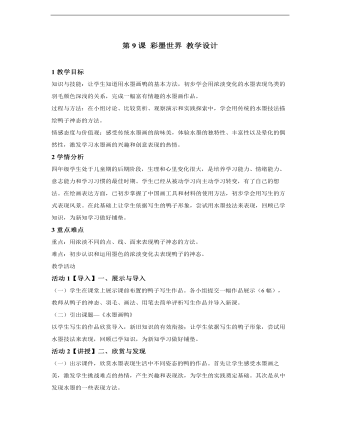
小学美术人教版四年级上册《第9课彩墨世界》教学设计说课稿模板
2学情分析四年级学生处于儿童期的后期阶段,生理和心里变化很大,是培养学习能力、情绪能力、意志能力和学习习惯的最佳时期。学生已经从被动学习向主动学习转变,有了自己的想法。在绘画表达方面,已初步掌握了中国画工具和材料的使用方法,初步学会用写生的方式表现风景。在此基础上让学生依据写生的鸭子形象,尝试用水墨技法来表现,回顾已学知识,为新知学习做好铺垫。

小学美术人教版四年级上册《第7课今天我值日》教学设计说课稿
一、谈话导入:师:咱们班今天是谁的值日生啊?学生反馈(教师请值日的学生回答并根据班级卫生情况做出简单评价或表扬。)师:今天的值日生表现非常棒,值日工作做的很好,希望其他同学向他(她)学习。那你们想不想把我们值日时的场面画在纸上呢?今天就让我们来学习第七课《今天我值日》。(打开课件)生:学生打开课本第七课《今天我值日》。

小学美术人教版四年级下册《第2课点的魅力2》教学设计说课稿
一、导入新课上课,同学们好!今天的美术课和平时有点不一样,主要有两个方面,其一、教室里来了许多老师和我们一起来上这一堂美术课,大家用掌声表示欢迎。其二、就是唐老师为大家带来了一位小伙伴,同学们肯定会喜欢上它的,大家看,它来了--展示课件动画图片和播放声音,出现一个小圆点,(说话:同学们,大家好!我的名字叫小圆点,我喜欢穿各种色彩的衣服,我的本领可大啦!能大能小,位置和大小的变化还能给人产生不一样的感觉!在生活中和美术作品中经常可以见到我的身影!大家都称我为魅力的小圆点呢!)
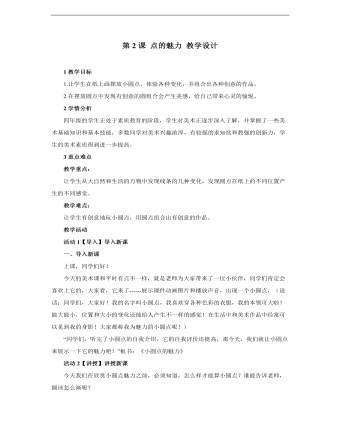
小学美术人教版四年级下册《第2课点的魅力1》教学设计说课稿
2学情分析四年级的学生正处于素质教育的阶段,学生对美术正逐步深入了解,并掌握了一些美术基础知识和基本技能,多数同学对美术兴趣浓厚,有较强的求知欲和教强的创新力,学生的美术素质得到进一步提高。3重点难点教学重点:让学生从大自然和生活的万物中发现线条的几种变化,发现圆点在纸上的不同位置产生的不同感觉。
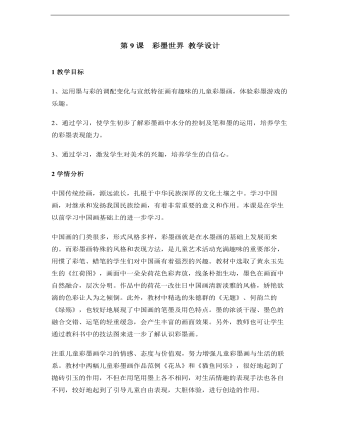
小学美术人教版四年级上册《第9课彩墨世界》教学设计说课稿
2学情分析中国传统绘画,源远流长,扎根于中华民族深厚的文化土壤之中。学习中国画,对继承和发扬我国民族绘画,有着非常重要的意义和作用。本课是在学生以前学习中国画基础上的进一步学习。中国画的门类很多,形式风格多样,彩墨画就是在水墨画的基础上发展而来的。而彩墨画特殊的风格和表现方法,是儿童艺术活动充满趣味的重要部分,用惯了彩笔、蜡笔的学生们对中国画有着强烈的兴趣。教材中选取了黄永玉先生的《红荷图》,画面中一朵朵荷花色彩奔放,线条朴拙生动,墨色在画面中自然融合,层次分明。作品中的荷花一改往日中国画清新淡雅的风格,娇艳欲滴的色彩让人为之倾倒。此外,教材中精选的朱德群的《无题》、何韵兰的《绿殇》,也较好地展现了中国画的笔墨及用色特点。墨的浓淡干湿、墨色的融合交错、运笔的轻重缓急,会产生丰富的画面效果。另外,教师也可让学生通过教科书中的技法图来进一步了解认识彩墨画。
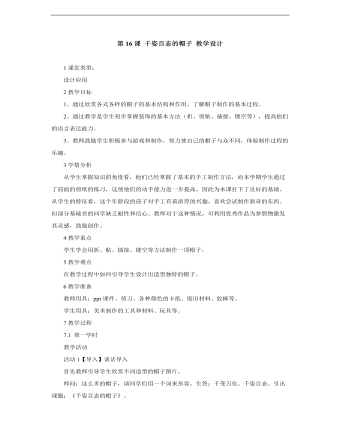
小学美术人教版四年级下册《第16课千姿百态的帽子》教学设计说课稿
1、通过欣赏各式各样的帽子的基本结构和作用。了解帽子制作的基本过程。2、通过教学是学生初步掌握装饰的基本方法(折、剪贴、插接、镂空等),提高他们的语言表达能力。3、教师鼓励学生积极参与游戏和制作,努力使自己的帽子与众不同,体验制作过程的乐趣。3学情分析从学生掌握知识的角度看,他们已经掌握了基本的手工制作方法,而本学期学生通过了前面的剪纸的练习,这使他们的动手能力进一步提高,因此为本课打下了良好的基础。从学生的特征看,这个年龄段的孩子对手工有着浓厚的兴趣,喜欢尝试制作新奇的东西。但部分基础差的同学缺乏耐性和信心。教师对于这种情况,可利用优秀作品为参照物激发其灵感,鼓励创作。
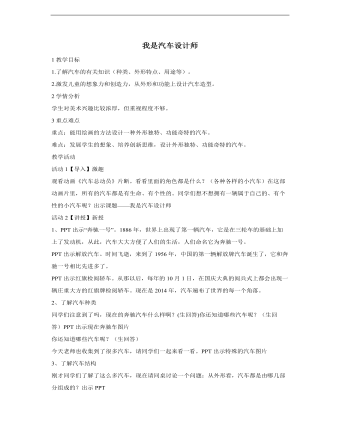
小学美术人教版四年级上册《第10课我是汽车设计师》教学设计说课稿
活动1【导入】激趣观看动画《汽车总动员》片断。看看里面的角色都是什么?(各种各样的小汽车)在这部动画片里,所有的汽车都是有生命、有个性的。同学们想不想拥有一辆属于自己的、有个性的小汽车呢?出示课题——我是汽车设计师活动2【讲授】新授1、PPT出示“奔驰一号”。1886年,世界上出现了第一辆汽车,它是在三轮车的基础上加上了发动机,从此,汽车大大方便了人们的生活,人们命名它为奔驰一号。PPT出示解放汽车。时间飞逝,来到了1956年,中国的第一辆解放牌汽车诞生了,它和奔驰一号相比先进多了。
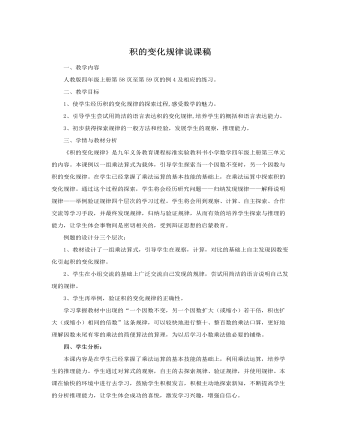
人教版新课标小学数学四年级上册积的变化规律说课稿
三、学情与教材分析《积的变化规律》是九年义务教育课程标准实验教科书小学数学四年级上册第三单元的内容。本课例以一组乘法算式为载体,引导学生探索当一个因数不变时,另一个因数与积的变化规律。在学生已经掌握了乘法运算的基本技能的基础上,在乘法运算中探索积的变化规律。通过这个过程的探索,学生将会经历研究问题——归纳发现规律——解释说明规律——举例验证规律四个层次的学习过程。学生将会用到观察、计算、自主探索、合作交流等学习手段,并最终发现规律,归纳与验证规律,从而有效的培养学生探索与推理的能力,让学生体会事物间是密切相关的,受到辩证思想的启蒙教育。例题的设计分三个层次:1、教材设计了一组乘法算式,引导学生在观察,计算,对比的基础上自主发现因数变化引起积的变化规律。
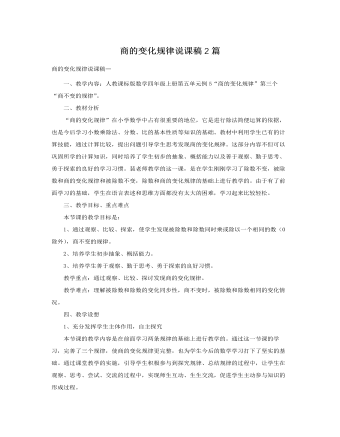
人教版新课标小学数学四年级上册商的变化规律说课稿2篇
第三个规律,商不变的规律。这是本课的重点内容。有了两次的探究经验,这一规律的学习与理解,可以完全放手让学生自主进行。猜想如果商不变,被除数、除数会发生什么变化呢?学生根据已有的经验,可能会有不同猜想,我要求学生带着问题通过计算、观察、比较、主动探讨总结出:被除数和除数同时扩大(或缩小)相同的倍数(0除外)商不变。利用合作学习,通过动脑动口动手,既提高学生解决问题的学习能力,又培养了合作学习的意识和习惯。给学生提供展示研究成果的机会,体验成功。需要教师提醒的是“有没有被除数和除数同时乘或除以不相同的数,商也不变的?”学生举反例加以说明并指出“相同的倍数不包括0”。设计这个环节,也有意让学生去验证商不变性质。学生在表述时,对于逻辑的严密性和语言的完整性需要老师及时指导,在突出重点的同时培养学生的语言表达能力。整个环节在验证的基础上,步步深化商的变化规律,为学生应用新知做好铺垫。

